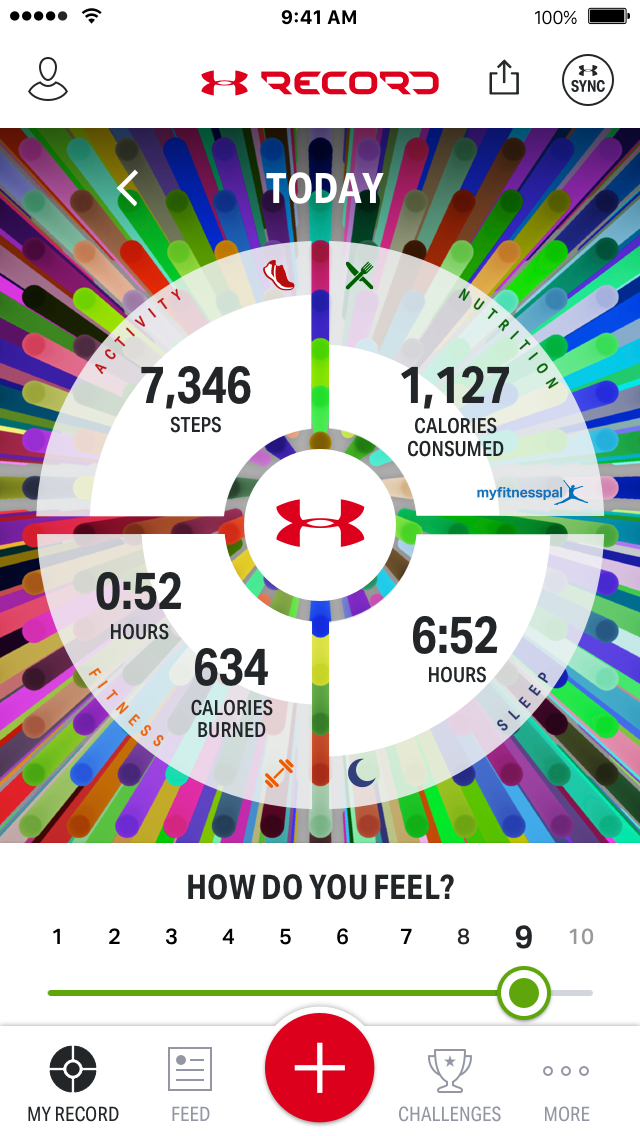Under Armour (UA 5.92%) released a line of all-new Connected Fitness products at the Consumer Electronics Show in Las Vegas on Jan. 5. The gear won't be available until mid-February, but Under Armour gave me each of these products in December so that I could put together a full review. I've been using them since, and here's everything you need to know about these new connected products, and why this segment looks so promising for Under Armour investors.
The products
Under Armour's new products include a fitness and sleep-tracking wrist band, a heart rate-monitoring chest strap, and a connected scale, all manufactured by HTC Corporation (NASDAQOTH: HTCXF). The three items come together in the Under Armour HealthBox for $400, or each item can be purchased individually ($180 each for the band and scale, and $80 for the chest strap). Units from UnderArmour.com will ship to consumers starting Feb. 15, and will be available at Under Armour Brand house stores Feb. 22, though there is no released date for when they will be available at other sports stores.

The connected wrist band, chest strap, and scale that Under Armour showed off at CES. Image: Under Armour.
Under Armour's new gear also includes wireless headphones manufactured by Harman (HAR +0.00%), connected shoes made in-house, and an updated version of the Under Armour Record app. I've been using all of these products every day for the past five weeks, and here's what I've found.

The UA band. Photo: Under Armour.
UA Band
The wristband records steps, along with distance and estimated calories burned; allows users to start recording a workout directly on the wristband, which automatically syncs to Under Armour's Record app; and can show heart rate when prompted.
What I have found to be the best feature of the wristband is how well it tracks sleep automatically without the user needing to start or end recording the sleep period. Similar sleep tracking apps require the user the tap "start sleep" before bed, and "end sleep" when they wake up, which risks forgetting some nights/mornings, and isn't fully accurate unless you can fall asleep immediately after beginning recording. Also, the band takes the user's heart rate every 15 minutes to come up with the resting heart rate of that night's sleep. The idea is that as you get healthier, your resting heart rate should get lower, making this a quick and easy-to-follow data point of overall fitness.
When asked why the band doesn't record heart rate constantly as competing products do, the UA team said it's not very helpful to look at heart rate constantly throughout the day when a cup of coffee, temperature, and other fluctuating factors can give results that are too hard to correlate to a personal fitness trend. Resting heart rate more accurately shows the long-term fitness trend, and monitoring resting heart rate while sleeping gives a reading that's easy to understand and consistent (you're usually in the same position and temperature, and over the hours the effects of your food wear off). Meanwhile, less time tracking heart rate helps the band to conserve the battery, which surprisingly lasts about five days.
UA Heart Rate
Why do you need this chest strap if there is a heart rate monitor on the band itself? No wristband has the technology yet to be as accurate as the chest strap, according to Under Armour's product team, making this device necessary when you want the most accurate possible recording. There are no screens or buttons on the chest strap, it simply turns on by sensing touch and connects automatically. When you are wearing the chest strap and then start recording a workout directly on the band, the screen on the band shows your heart rate, estimated calories burned, and "Willpower" (Under Armour's 10-point scale of how intense your workout is). There is also an LED light on the side of the band that changes color to show what heart-rate zone you're in during a workout.
UA Scale
There are many connected scales that measure both weight and body-fat percentage, connect to a user's smartphone, and are able to record stats for multiple users. What's different about this one is that it syncs on Wi-Fi instead of just Bluetooth, so that you can record your stats each day without syncing it to your phone, but it will still automatically update your profile on the Record app. Also, it automatically detects which user is standing on it based on body weight -- though you can switch profiles with a foot tap, too, in case two users have similar weights. The other striking difference is that this scale's sleek design, something that the Under Armour team talked about at length when showing me the product, saying that the company wanted to create a scale that users would be proud to have in their home.
Wireless headphones
The earbuds initially looked far too big to fit in my ear, but they're actually comfortable and stay in place well while running or working out. The Bluetooth seems to work well up to about 20 feet and the battery life has been great so far. These headphones aren't connected to the other fitness products yet, but headphones will be available in late spring that will include an in-ear heart-rate monitor that's said to be nearly as accurate as the chest strap. These wireless headphones will be sold for $180, and the coming heart rate monitoring headphones for $250.

UA wireless headphones. Photo: Under Armour.
UA Speedform Gemini 2: Record-equipped running shoes
The shoes are my favorite part of all of the gear, and as a runner I'm very impressed with the overall quality and feel, not to mention how good-looking they are. The soft mesh top makes them light and airy, while the one-piece design of the heel cup (much like a bra, as that was the inspiration) is surprisingly comfortable. Then there's the connectedness -- a chip in the shoe tracks steps, pace, and total distance and is said to be more accurate for distance and pace than GPS. The shoes can also track up to five runs before syncing, making tracking workouts a breeze even when running untethered. These shoes will be available from Under Armour starting Feb. 29 for $150.

UA Speedform Gemini, Record Equipped. Photo: Under Armour.
But isn't Under Armour too late to the wearable game?
The products are nice, and after using similar trackers I'm certainly impressed with what these ones do and how they look and feel. However, the market for wearables is already getting saturated with connected fitness trackers by companies large and small, so isn't Under Armour already late to the game behind companies such as Fitbit (FIT +0.00%), which has already established itself as the mass-market device leader over the past several years, and Garmin (GRMN 0.46%), which has led the market for high-tech wearables for serious athletes?
Under Armour has a few key competitive advantages in this space for the long term. First, Under Armour already has nearly $4 billion in annual sales, projected to reach $7.5 billion by 2018. These sales are mostly from apparel, meaning that a large base of fans worldwide already wear Under Armour's brand. As the shoes show and as the Under Armour team told me, Under Armour is working to make more apparel connected. Since Under Armour has already grown to be the second-largest athletic-apparel brand in the U.S. by market share and rapidly gaining internationally, future iterations of this kind of connected apparel will help Under Armour to grow in ways that companies such as Fitbit and Garmin simply can't do with their limited hardware products.

Under Armour's new version of its Record app. Photo: Under Armour.
Second, Under Armour's investment into its digital fitness community through acquisitions of apps such as MapMyFitness and MyFitnessPal have paid off, as the company now has nearly 160 million users across its various apps. It's clear that Under Armour is continuing to make this a key part of its strategy, as the new version of the Record app ties all of the other apps into one easy dashboard that reads and records stats from similar devices, including Fitbit and Garmin, and many other third-party products so that Under Armour will continue to own the user's experience, regardless of the product.
Finally, this is just the first generation of this gear. The Under Armour team says it's "just getting started" and that new iterations and products will be coming out over time. One benefit of starting later is that it's been able to learn from other companies' successes and failures to make products that are already ahead of the pack. With this impressive first generation of connected products, the chance to get more connected features into other apparel, and the digital community Under Armour already has that is still growing rapidly, this Connected Fitness segment continues to look like a great bet.







